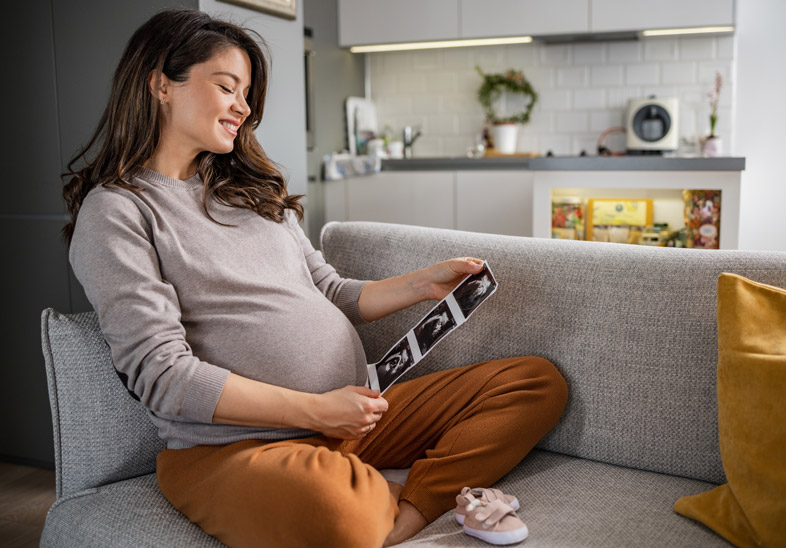
Artificial insemination
What is intrauterine insemination?

Intrauterine or artificial insemination is an assisted reproduction technique that involves depositing selected sperm in the uterus at the time of ovulation, with the aim of reducing the distance they must travel to reach the egg in the fallopian tubes.
If the sperm used is from the partner, we refer to this as Conjugal Artificial Insemination (CAI).
If the sperm comes from a donor, we refer to this as Donor Artificial Insemination (DAI).
What are the chances of successful treatment?

The success rate for Conjugal Artificial Insemination (CAI) is roughly 20% per cycle, compared with approximately 25% per treatment cycle for Donor Artificial Insemination (DAI).
It should be noted that the success of insemination depends on two determining factors: the woman's age and the quality of the semen.
If pregnancy is not achieved after three cycles of insemination, it may be advisable to move on to more complex techniques such as In Vitro Fertilisation (IVF).
The insemination cycle consists of three phases:
Ovulation stimulation
Ovulation stimulation seeks to ensure the proper release of an egg from an ovarian follicle and to manage the cycle to allow for synchronised ovulation and insemination, thereby enabling them to happen simultaneously.
The hormones are injected subcutaneously and administered in low doses to prevent the growth of more than one follicle, thereby forestalling multiple pregnancies.
The response to ovulation stimulation is also monitored using ultrasound scans and blood tests. When deemed sufficient, another hormone is administered to trigger ovulation a few hours later, and insemination is scheduled at that time. This phase lasts between 7 and 14 days.
Semen preparation in the laboratory
On the day of insemination, the male provides a semen sample, which is prepared in the laboratory to select the best spermatozoa. These are then loaded into a small volume of culture medium in a special cannula for intrauterine insemination. This removes dead sperm and other cellular debris from the initial semen sample.
When using donor semen, simply thaw the selected sample and prepare it as you would a fresh sample.
Insemination
The actual insemination is carried out in the doctor's office, where a cannula with the selected sample is inserted into the uterus and injected. It is a simple, painless procedure, and thus requires no anaesthesia.
After insemination, the patient is instructed to administer one 200 mg progesterone ovule daily, vaginally, to ensure good endometrial receptivity. This treatment continues for either 14 days, concluding with a blood pregnancy test, or 17 days, when using the urine-based test.
For which patients is insemination recommended?
The indications differ for CAI and DAI.
Conjugal Artificial Insemination (CAI) is indicated in the following situations:
- When the quality of the man's semen is slightly below normal (mild male factor)
- When a woman does not ovulate properly (ovulatory factor)
Donor Artificial Insemination (DAI) is indicated in the following situations:
- When semen is of low or very low quality (severe male factor)
- When the male is a carrier of hereditary diseases
- When a woman does not have a male partner
The prerequisite for both types of insemination is that the woman has permeable fallopian tubes to allow the sperm to meet the egg.
How does the semen preparation process work?
Semen preparation consists of separating the best sperm from the rest of the ejaculate (seminal plasma, immobile, slow or dead cells and sperm) efficiently and maintaining the fertilising capacity of the sperm.
Depending on the quality of the semen sample, the laboratory staff chooses the most appropriate preparation technique and, finally, the selected sperm population is concentrated in a small volume that is loaded into the cannula.
The process takes approximately 2-3 hours in the laboratory.
What are the risks for the patient?
The main risks of insemination are: multiple pregnancy, ectopic pregnancy, and ovarian hyperstimulation syndrome.
- Multiple pregnancies occur because, with ovarian stimulation, more than one follicle grows. While 88% of pregnancies following intrauterine insemination are single pregnancies, 11% are twin pregnancies, with an even lower risk of triplets (0.5%, according to data from the 2010 registry of the Spanish Fertility Association).
- An ectopic pregnancy occurs when the embryo implants outside the uterus, usually in the fallopian tubes. Its incidence is 1.7% (according to data from the 2010 registry of the Spanish Fertility Association).
- Ovarian hyperstimulation syndrome is caused by an excessive response of the ovary to medication, significant follicle growth and enlargement of the ovary. Its incidence is very low, less than 0.1% (according to data from the 2010 registry of the Spanish Fertility Association).
Is it possible to avoid the risk of multiple pregnancies?
The risk of multiple pregnancies can be minimised by closely monitoring the growth of follicles in the ovary. If the number of follicles is higher than recommended, insemination should be cancelled and, in the next cycle, the ovary should be stimulated with lower hormone doses than in the previous cycle.


































